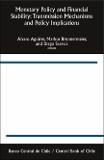Libro
Monetary policy and financial stability: transmission mechanisms and policy implications
Fecha
2019Resumen
The global financial crisis that broke out 10 years ago uncovered the buildup of risks during a period of price and output stability. It challenged the previous consensus that preserving price stability was the optimal way to ensure financial stability, and led to a surge of interest in the multiple interactions between monetary policy frameworks, financial vulnerabilities and financial stability. This volume contributes to the study of these issues as well as the convenience of incorporating financial stability considerations in monetary policy frameworks, bringing together a multinational group of distinguished scholars to discuss the latest research findings. It is of utmost importance to understand how monetary policy affects both financial conditions and financial vulnerabilities that amplify negative shocks, as well as the potential intertemporal policy trade-off between improving current conditions and exacerbating future financial vulnerabilities. Monetary Policy and Financial Stability: Transmission Mechanisms and Policy Implications – An Overview / Álvaro Aguirre, Markus Brunnermeier, and Diego Saravia -- Negative Interest Rates: Lessons from the Euro Area / Jens Eisenschmidt and Frank Smets -- Central Banks Going Long / Ricardo Reis -- Capital Flows, Macroprudential Policies and Capital Controls / Álvaro Aguirre, Sofía Bauducco, and Diego Saravia -- A Global Safe Asset for and from Emerging Market Economies / Markus K. Brunnermeier and Lunyang Huang -- Capital Flow Management with Multiple Instruments / Viral V. Acharya and Arvind Krishnamurthy -- Foreign Exchange Intervention Redux / Roberto Chang -- Interest Rate Policies, Banking and the Macroeconomy / Vincenzo Quadrini -- The Relation between Monetary Policy and Financial-Stability Policy / Lars E.O. Svensson -- Monetary Policy in the Grip of a Pincer Movement / Claudio Borio, Piti Disyatat, Mikael Juselius, and Phurichai Rungcharoenkitkul.
Colecciones
Descargar


